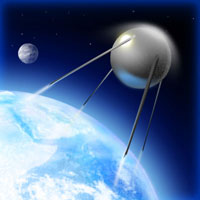World celebrates 50th anniversary of first-ever man-made satellite Sputnik
Engineers, military officials and former cosmonauts on Thursday celebrated the 50th anniversary of the launch of the world's first artificial satellite, Sputnik, which marked the dawn of the Space Age and sparked the race to land a man on the moon.

Ceremonies were held at the Russia's cosmonaut training center, Star City, outside of Moscow and engineers were to gather at the Academy of Sciences to recall the events leading up to the Oct. 4, 1957, launch of the spikey, 184 pound (83-kilogram) metal ball that beeped as it circled the globe for some 22 days.
Military officials held a small ceremony to lay flowers at the grave of the father of the Soviet space program, Sergei Korolyov, who was buried with honors at the foot of the Kremlin walls.
The success of Soviet engineers in launching Sputnik stunned the world, and was followed just four years later by another historic achievement - the launch of Yuri Gagarin, the first human in space.
Sputnik galvanized the U.S. government to pour money into space research and technology with the goal of landing a man on the moon - an event that occurred nearly 12 years later.
"Of course speaking just for us specialists (the launch) sparked an unexpected furor around the world. No one expected this, even including our engineers," Viktor Frusmon, a co-worker of Korolyov's, said in a televised comments Thursday.
The satellite was 58 cm (about 23 in) in diameter and weighed approximately 83.6 kg (about 183 lb). Each of its elliptical orbits around the Earth took about 96 minutes.
Sputnik 2 was launched on November 3, 1957 and carried the first living passenger into orbit, a dog named Laika. The mission planners did not provide for the safe return of the spacecraft or its passenger, making Laika the first orbital casualty. This mission was promptly dubbed "Muttnick" by humorists.
The first attempt to launch Sputnik 3, on February 3, 1958, failed, but the second on May 15 succeeded, and it carried a large array of instruments for geophysical research. Its tape recorder failed, however, making it unable to measure the Van Allen radiation belts.
Sputnik 4 was launched two years later, on May 15, 1960.
Sputnik 5 was launched on August 19, 1960 with the dogs Belka and Strelka, 40 mice, 2 rats and a variety of plants on board. The spacecraft returned to earth the next day and all animals were recovered safely.
Subscribe to Pravda.Ru Telegram channel, Facebook, RSS!


